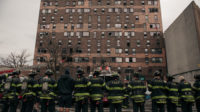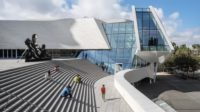New Art Parks Enliven Urban Centers

New Arts Parks Enliven Urban Centers
Citygarden—a $30 million, 2.9-acre park designed by Virginia-based Nelson Byrd Woltz—opened this summer in St. Louis. The park is part of a long-underused public space that extends 1.1 miles west of the Gateway Arch. Funded by the Gateway Foundation, it features a reflecting pool and 24 sculptures by artists such as Jim Dine and Martin Puryear. “With one stroke, Citygarden has made downtown so much more attractive as a place to do business. And as a place to live, too,” Mayor Francis Slay said during the opening ceremony.
Image courtesy Gateway Foundation

New Arts Parks Enliven Urban Centers
Citygarden—a $30 million, 2.9-acre park designed by Virginia-based Nelson Byrd Woltz—opened this summer in St. Louis. The park is part of a long-underused public space that extends 1.1 miles west of the Gateway Arch. Funded by the Gateway Foundation, it features a reflecting pool and 24 sculptures by artists such as Jim Dine and Martin Puryear. “With one stroke, Citygarden has made downtown so much more attractive as a place to do business. And as a place to live, too,” Mayor Francis Slay said during the opening ceremony.
Image courtesy Gateway Foundation

New Arts Parks Enliven Urban Centers
Citygarden—a $30 million, 2.9-acre park designed by Virginia-based Nelson Byrd Woltz—opened this summer in St. Louis. The park is part of a long-underused public space that extends 1.1 miles west of the Gateway Arch. Funded by the Gateway Foundation, it features a reflecting pool and 24 sculptures by artists such as Jim Dine and Martin Puryear. “With one stroke, Citygarden has made downtown so much more attractive as a place to do business. And as a place to live, too,” Mayor Francis Slay said during the opening ceremony.
Image courtesy Gateway Foundation

New Arts Parks Enliven Urban Centers
Citygarden—a $30 million, 2.9-acre park designed by Virginia-based Nelson Byrd Woltz—opened this summer in St. Louis. The park is part of a long-underused public space that extends 1.1 miles west of the Gateway Arch. Funded by the Gateway Foundation, it features a reflecting pool and 24 sculptures by artists such as Jim Dine and Martin Puryear. “With one stroke, Citygarden has made downtown so much more attractive as a place to do business. And as a place to live, too,” Mayor Francis Slay said during the opening ceremony.
Image courtesy Gateway Foundation

New Arts Parks Enliven Urban Centers
Citygarden—a $30 million, 2.9-acre park designed by Virginia-based Nelson Byrd Woltz—opened this summer in St. Louis. The park is part of a long-underused public space that extends 1.1 miles west of the Gateway Arch. Funded by the Gateway Foundation, it features a reflecting pool and 24 sculptures by artists such as Jim Dine and Martin Puryear. “With one stroke, Citygarden has made downtown so much more attractive as a place to do business. And as a place to live, too,” Mayor Francis Slay said during the opening ceremony.
Image courtesy Gateway Foundation

New Arts Parks Enliven Urban Centers
For its pending reconstruction of Dilworth Plaza, located in front of Philadelphia’s City Hall, KieranTimberlake will “restore to prominence the extraordinary public art program of Alexander [Stirling] Calder,” says partner Stephen Kieran, FAIA, referring to the sculptor who created many installations for Philadelphia. (Calder’s son, Alexander Calder, was the famous artist best known for his mobiles.) The Dilworth Plaza scheme calls for a lawn, large fountain, and two glass pavilions that will serve as a subway-station entrance.
Image courtesy KieranTimberlake

New Arts Parks Enliven Urban Centers
For its pending reconstruction of Dilworth Plaza, located in front of Philadelphia’s City Hall, KieranTimberlake will “restore to prominence the extraordinary public art program of Alexander [Stirling] Calder,” says partner Stephen Kieran, FAIA, referring to the sculptor who created many installations for Philadelphia. (Calder’s son, Alexander Calder, was the famous artist best known for his mobiles.) The Dilworth Plaza scheme calls for a lawn, large fountain, and two glass pavilions that will serve as a subway-station entrance.
Image courtesy KieranTimberlake

New Arts Parks Enliven Urban Centers
For its pending reconstruction of Dilworth Plaza, located in front of Philadelphia’s City Hall, KieranTimberlake will “restore to prominence the extraordinary public art program of Alexander [Stirling] Calder,” says partner Stephen Kieran, FAIA, referring to the sculptor who created many installations for Philadelphia. (Calder’s son, Alexander Calder, was the famous artist best known for his mobiles.) The Dilworth Plaza scheme calls for a lawn, large fountain, and two glass pavilions that will serve as a subway-station entrance.
Image courtesy KieranTimberlake

New Arts Parks Enliven Urban Centers
In late September, Des Moines saw the much-anticipated opening of the 4.4-acre John and Mary Pappajohn Sculpture Park. Featuring 16 pieces donated by the Pappajohns, local philanthropists, the project was designed by New York architects Diana Agrest, FAIA, and Mario Ganelsonas, AIA, who developed a master plan for Des Moines in the early 1990s. The park offers users of the downtown district the twin benefits of high-quality outdoor space and fine art. “This provides us an ability to reach an audience that would think to come to a beautiful public space, but might not consider visiting the museum,” says Jeff Fleming, director of the Des Moines Arts Center, which contributed $6.1 million to the project.
Image courtesy Des Moines Art Center

New Arts Parks Enliven Urban Centers
In late September, Des Moines saw the much-anticipated opening of the 4.4-acre John and Mary Pappajohn Sculpture Park. Featuring 16 pieces donated by the Pappajohns, local philanthropists, the project was designed by New York architects Diana Agrest, FAIA, and Mario Ganelsonas, AIA, who developed a master plan for Des Moines in the early 1990s. The park offers users of the downtown district the twin benefits of high-quality outdoor space and fine art. “This provides us an ability to reach an audience that would think to come to a beautiful public space, but might not consider visiting the museum,” says Jeff Fleming, director of the Des Moines Arts Center, which contributed $6.1 million to the project.
Image courtesy Des Moines Art Center

New Arts Parks Enliven Urban Centers
In late September, Des Moines saw the much-anticipated opening of the 4.4-acre John and Mary Pappajohn Sculpture Park. Featuring 16 pieces donated by the Pappajohns, local philanthropists, the project was designed by New York architects Diana Agrest, FAIA, and Mario Ganelsonas, AIA, who developed a master plan for Des Moines in the early 1990s. The park offers users of the downtown district the twin benefits of high-quality outdoor space and fine art. “This provides us an ability to reach an audience that would think to come to a beautiful public space, but might not consider visiting the museum,” says Jeff Fleming, director of the Des Moines Arts Center, which contributed $6.1 million to the project.
Image courtesy Des Moines Art Center

New Arts Parks Enliven Urban Centers
In late September, Des Moines saw the much-anticipated opening of the 4.4-acre John and Mary Pappajohn Sculpture Park. Featuring 16 pieces donated by the Pappajohns, local philanthropists, the project was designed by New York architects Diana Agrest, FAIA, and Mario Ganelsonas, AIA, who developed a master plan for Des Moines in the early 1990s. The park offers users of the downtown district the twin benefits of high-quality outdoor space and fine art. “This provides us an ability to reach an audience that would think to come to a beautiful public space, but might not consider visiting the museum,” says Jeff Fleming, director of the Des Moines Arts Center, which contributed $6.1 million to the project.
Image courtesy Des Moines Art Center

New Arts Parks Enliven Urban Centers
In late September, Des Moines saw the much-anticipated opening of the 4.4-acre John and Mary Pappajohn Sculpture Park. Featuring 16 pieces donated by the Pappajohns, local philanthropists, the project was designed by New York architects Diana Agrest, FAIA, and Mario Ganelsonas, AIA, who developed a master plan for Des Moines in the early 1990s. The park offers users of the downtown district the twin benefits of high-quality outdoor space and fine art. “This provides us an ability to reach an audience that would think to come to a beautiful public space, but might not consider visiting the museum,” says Jeff Fleming, director of the Des Moines Arts Center, which contributed $6.1 million to the project.
Image courtesy Des Moines Art Center

New Arts Parks Enliven Urban Centers
The Virginia B. Fairbanks Art & Nature Park—adjacent to the Indianapolis Museum of Art and opening in June 2010—will draw people to central Indianapolis. Lisa Freiman, park director and IMA curator, plans to rotate site-specific commissions through the 100-acre parcel, with a Marlon Blackwell-designed visitor center providing one constant.
Image courtesy IMA

New Arts Parks Enliven Urban Centers
The Virginia B. Fairbanks Art & Nature Park—adjacent to the Indianapolis Museum of Art and opening in June 2010—will draw people to central Indianapolis. Lisa Freiman, park director and IMA curator, plans to rotate site-specific commissions through the 100-acre parcel, with a Marlon Blackwell-designed visitor center providing one constant.
Image courtesy IMA

New Arts Parks Enliven Urban Centers
The Virginia B. Fairbanks Art & Nature Park—adjacent to the Indianapolis Museum of Art and opening in June 2010—will draw people to central Indianapolis. Lisa Freiman, park director and IMA curator, plans to rotate site-specific commissions through the 100-acre parcel, with a Marlon Blackwell-designed visitor center providing one constant.
Image courtesy IMA

New Arts Parks Enliven Urban Centers
The Virginia B. Fairbanks Art & Nature Park—adjacent to the Indianapolis Museum of Art and opening in June 2010—will draw people to central Indianapolis. Lisa Freiman, park director and IMA curator, plans to rotate site-specific commissions through the 100-acre parcel, with a Marlon Blackwell-designed visitor center providing one constant.
Image courtesy IMA

New Arts Parks Enliven Urban Centers
The Virginia B. Fairbanks Art & Nature Park—adjacent to the Indianapolis Museum of Art and opening in June 2010—will draw people to central Indianapolis. Lisa Freiman, park director and IMA curator, plans to rotate site-specific commissions through the 100-acre parcel, with a Marlon Blackwell-designed visitor center providing one constant.
Image courtesy IMA

New Arts Parks Enliven Urban Centers
The Virginia B. Fairbanks Art & Nature Park—adjacent to the Indianapolis Museum of Art and opening in June 2010—will draw people to central Indianapolis. Lisa Freiman, park director and IMA curator, plans to rotate site-specific commissions through the 100-acre parcel, with a Marlon Blackwell-designed visitor center providing one constant.
Image courtesy IMA





Post a comment to this article
Report Abusive Comment